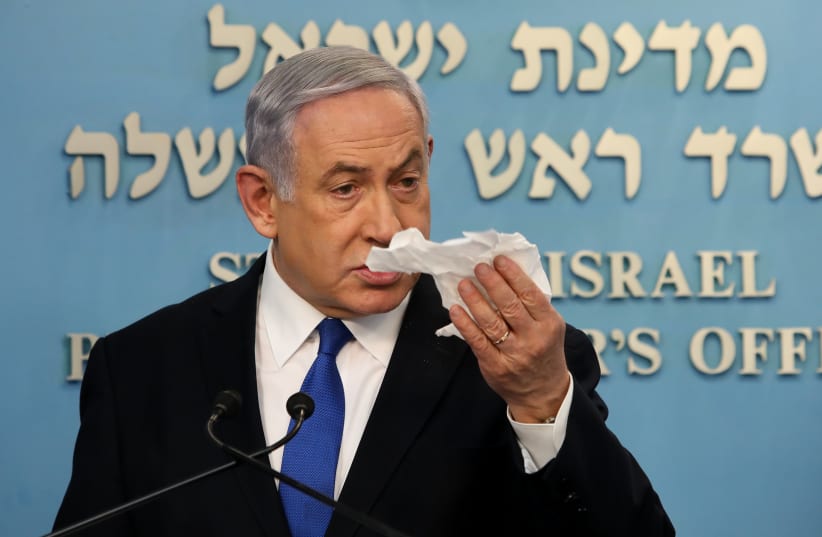Israel has a long history of crises spawning commissions of inquiry that criticize the decision-making process during the crisis under investigation.
It happened with the famed Agranat Commission that followed the 1973 Yom Kippur War, when one of the recommendations was for the establishment of a formal security cabinet to replace Golda Meir's informal “Kitchen Cabinet.”
And it happened again with the Winograd Commission interim report that investigated the Second Lebanon War and found that the security cabinet under prime minister Ehud Olmert did not function properly during the conflict.
The nation won't have to wait months for a commission of inquiry to release its findings once the coronavirus disappears – a faulty decision-making process was on full display Saturday night when Prime Minister Benjamin Netanyahu, Health Ministry director-general Moshe Bar Siman Tov, and Finance Minister director-general Shai Babad unveiled new steps to begin partially re-opening the country.
Though nothing overly dramatic, the measures – an increase in office workers, the opening of some stores, allowance of outdoor prayer quorums and increased public transportation – were a welcome relief after six weeks when the televised announcements by the Netanyahu-Bar Siman Tov-Babad triumvirate presaged more, not fewer, restrictions.
What was less welcoming was the backward way in which the decisions that impact so heavily on so many people's lives were made.
In a perfect world, or even just in a world with a well-functioning permanent government in place, this is what an orderly coronavirus decision-making process would look like:
An advisory panel of experts – both from inside and outside the government – would draw up an exit plan taking into consideration the health, economic, social and security ramifications of the plan.
The plan would then be brought for debate to a special ministerial panel – call it the corona cabinet – that should have been established the minute the magnitude of the plague was known. If the fight against corona is, as Netanyahu has said repeatedly, a war, then surely a special inner cabinet to deal with this “war” should have been established and functioning, just as the security cabinet is empowered to function in times of traditional wars and national security emergencies.
The coronavirus cabinet would then – in a perfect world – have debated the plan, tweaked it where necessary and approved it. From there it would have gone to the full cabinet, for its input and a final vote.
Only when the cabinet had approved the plan, could it then have been rolled out to the public. And the roll-out should have been done in a timely, orderly manner. All the relevant questions should have been addressed, so that the public would know what is expected of it: what exactly is permitted and forbidden on a particular day. Questions, of course, would be entertained by the speakers rolling out the plan.
The new regulations, furthermore, should have been accompanied by an explanation as to why certain steps were allowed, while others were still being withheld. If the government expects the public to abide by the regulations, it should explain the reasoning. For example, why exactly are Israelis still being asked to remain within 100 meters of their homes?
The above is the scenario when the decision-making process goes by the book. And here is what happened in reality:
Netanyahu, Bar Siman Tov and Babad appeared on national television on Saturday night – not a press conference, because no questions were allowed – and announced that new directives would go into effect based on discussions with a slew of experts whose identities were not revealed. Netanyahu dropped the name twice of one expert he spoke to – A Harvard University epidemiologist named Marc Lipsitch – in what sounded like he was saying to the public, “Trust us, we spoke to an expert from Harvard!”
After the outline of the regulations were announced, and after the Health Ministry had already printed them out ready to distribute, only then was the cabinet convened for a late-night discussion and vote.
With a few minor changes, as if to save face, the ministers approved the regulations that had previously been announced.
This is an example of a decision-making process carried out in reverse, something that has become the norm during this crisis: first an announcement of regulations, and then a cabinet vote to approve them, rather than the other way around.
What is telling about this process is that it has generated so little push-back from ministers who have been turned into little more than rubber stamps.
One likely reason why the ministers have tolerated this situation is because the government making these emergency decisions is only a transitional one, not a permanent government, and the ministers are unlikely to be in their roles in any event in a few months time. So why challenge the decisions the boss wants to see implemented?
The end result: the prime minister, after consulting anonymous experts and specialists, makes decisions, and the government ministers – presented with them after they have already been announced – nod their heads in agreement.
To say this is not a healthy, text-book decision making process where debate and contrary opinions are aired, and where the ministers have real input, is an understatement. Which is a shame, because regardless of whether the decisions being made are correct or not, a streamlined, transparent decision-making process is needed – as critical decisions are being made that will impact people's lives and the economy for years.
